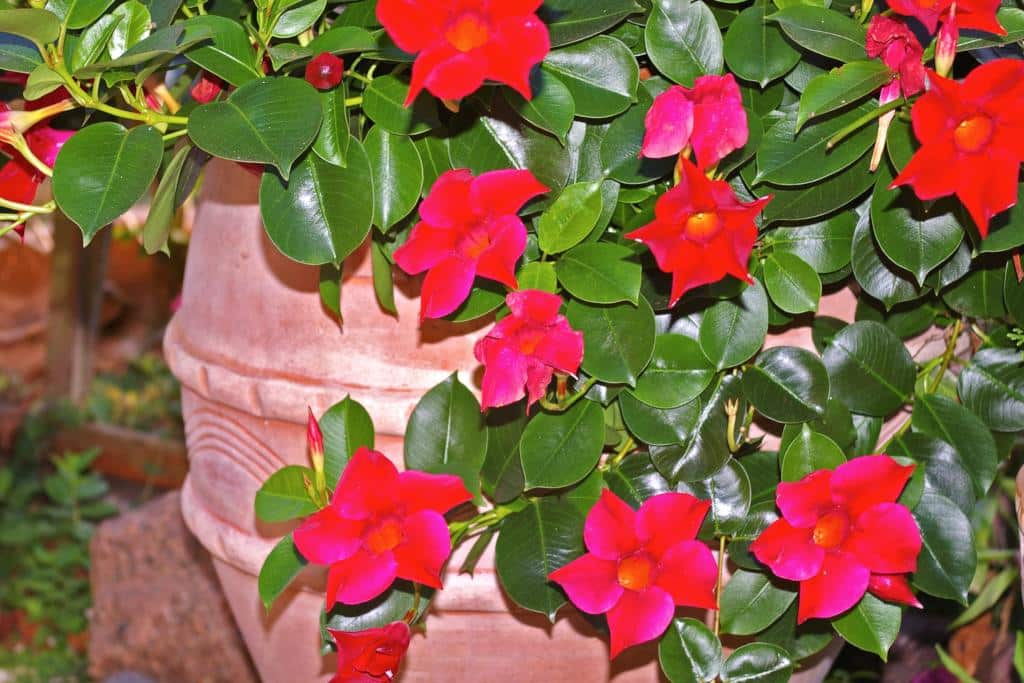Rio Dipladenia Come Back Every Year

They can survive in USDA zone 8 although they may die back each year and grow as shorter plants.
Rio dipladenia come back every year. They can survive in USDA zone 8 although they may die back each year and grow as shorter plants. They have a long bloom period. Proper winter care ensures that the dipladenia will survive to bloom again each summer.
Some foliage may die but your Rios should produce new foliage in spring. Furthermore do Dipladenia come back every year. Do Dipladenia come back every year.
Do not fertilize during winter as. The Gardeners Answer. The Rio Dipladenia is a gorgeous trumpet-shaped tropical flower that actually thrives in low-maintenance environments.
Now there are long vines coming out of two of them but not the other two. Do Rio Dipladenia come back every year. Similarly do Dipladenia come back every year.
Proper winter care ensures that the dipladenia will survive to bloom again each summer. In the first year you will see that they will outgrow the pot. They can survive in USDA zone 8 although they may die back each year and grow as shorter plants.
Heres why they make the perfect centrepiece in any cottage floral display. Availability of colors or sizes varies based on your local store. They can survive in USDA zone 8 although they may die back each year and grow as shorter plants.

They have a long bloom period.
Rio dipladenia come back every year. In the 2nd year they will be too big to suit the pot so search for a bigger area where you can plant them. The Mandevilla plant flowers come in a large variety of shades consisting of crimson pink yellow purple cream and white. Dipladenia is the former name of the plant with most cultivars now properly labeled and sold as mandevilla vines.
They can survive in USDA zone 8 although they may die back each year and grow as shorter plants. They can survive in USDA zone 8 although they may die back each year and grow as shorter plants. This means they will not survive our winter temperatures but they can be overwintered indoors and then taken back out the following spring.
Fertilize every three to four weeks during the growing season with a liquid plant food as part of good dipladenia care. The Gardeners Answer. Availability of colors or sizes varies based on your local store.
Growing mandevilla and dipladenia in pots When grown in containers it is advised to repot every 1 or 2 years in spring. Furthermore do Dipladenia come back every year. Similarly do Dipladenia come back every year.
Dipladenia is the former name of the plant with most cultivars now properly labeled and sold as mandevilla vines. One of the leading factors why garden enthusiasts choose the Mandevilla plant is due to the fact that it can enhance your houses visual appeals. No fertilizer is needed during the resting period but dipladenia appreciates extra nutrients while blooming.
Proper winter care ensures that the dipladenia will survive to bloom again each summer. The Rio Dipladenia is a gorgeous trumpet-shaped tropical flower that actually thrives in low-maintenance environments. Proper winter care ensures that the dipladenia will survive to bloom again each summer.

Click to see full answer.
Rio dipladenia come back every year. The Mandevilla plant flowers come in a large variety of shades consisting of crimson pink yellow purple cream and white. They can survive in USDA zone 8 although they may die back each year and grow as shorter plants. Fertilize every three to four weeks during the growing season with a liquid plant food as part of good dipladenia care.
Avoid placing this potted plant in excessively hot sunlight when on a terrace or balcony. Some foliage may die but your Rios should produce new foliage in spring. Bring your tropical inside before the first frost and place it in a.
Short blooming flowers are okay when you can guarantee youll enjoy every colourful moment. They can survive in USDA zone 8 although they may die back each year and grow as shorter plants. In cooler locations and.
Heres why they make the perfect centrepiece in any cottage floral display. Growing mandevilla and dipladenia in pots When grown in containers it is advised to repot every 1 or 2 years in spring. They can survive in USDA zone 8 although they may die back each year and grow as shorter plants.
Rio dipladenias come pre-fertilized but plants that have been over-wintered can be fertilized once in May and once in August with slow-release 18-6-12 fertilizer. Indoors is it best to place them near light but not in direct sunlight. Similarly do Dipladenia come back every year.
Proper winter care ensures that the dipladenia will survive to bloom again each summer. Have never grown dipladenia before so I would like to know what these vines are. Proper winter care ensures that the dipladenia will survive to bloom again each summer.









